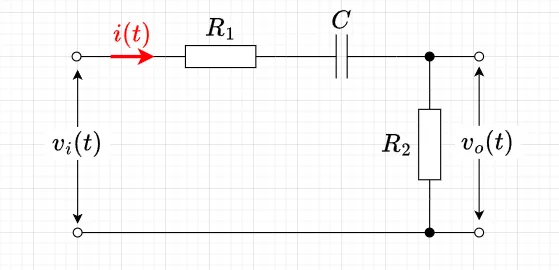1. 伝達関数と時間応答
1-1. インパルス応答から伝達関数
インパルス応答が、$$y(t) = 4e^{-2t} + 3e^{-5t}$$であるとき、システムの伝達関数を求めよ。
解答例:インパルス応答が\(y(t) = 4e^{-2t} + 3e^{-5t}\)なので、このラプラス変換が伝達関数となる。$$G(s) = \mathcal{L}\{g(t)\} = 4\mathcal{L}\{e^{-2t}\} + 3\mathcal{L}\{e^{-5t}\} = \frac{4}{s+2} + \frac{3}{s+5} = \frac{7s + 26}{(s+2)(s+5)}$$
※Scilabスクリプトと実行結果(インパルス応答波形と伝達関数のボード線図を図1)に示す。簡単なスクリプトでインパルス応答波形とボード線図を描けるが、インパルス応答から伝達関数の変換は、基本的に手計算となる。(インパルス応答波形から2次系モデルフィッティングなどで伝達関数を推定する方法はある。)
//Scilabスクリプト
// インパルス応答と伝達関数のグラフ
// 時間範囲の設定
t = 0:0.01:5;
// インパルス応答
y = 4 * exp(-2 * t) + 3 * exp(-5 * t);
// プロット (インパルス応答)
clf();
subplot(2, 1, 1);
plot(t, g, 'b-', 'LineWidth', 2);
xlabel('Time [s]');
ylabel('Impulse Response y(t)');
title('Impulse Response: y(t) = 4e^{-2t} + 3e^{-5t}');
xgrid;
// 伝達関数の定義
s = %s;
G = 4 / (s + 2) + 3 / (s + 5);
Gs =syslin('c',H);
// ボード線図の描画
subplot(2, 1, 2);
bode(Gs,'rad');
title('Bode Plot of Transfer Function H(s)');

※Pythonでは、ラプラス変換を実行できるので、インパルス応答の式から伝達関数の導出ができる。
#Pythonスクリプト
import sympy as sp
import numpy as np
import matplotlib.pyplot as plt
from scipy.signal import bode, lti
# シンボルの定義
t, s = sp.symbols('t s')
# インパルス応答の定義
y_t = 4 * sp.exp(-2 * t) + 3 * sp.exp(-5 * t)
# ラプラス変換
Y_s = sp.laplace_transform(y_t, t, s, noconds=True)
# 伝達関数の表示
print("Transfer Function in Laplace domain:")
display(Y_s)
実行結果:

1-2. 伝達関数からインパルス応答
伝達関数が、$$G(s) = \frac{4s+1}{(s+2)(s+3)}$$であるときのインパルス応答を求めよ。
解答例:伝達関数の逆ラプラス変換がインパルス応答である。まず、伝達関数\(G(s)\)を部分分数展開する。$$G(s) = \frac{4s+1}{(s+2)(s+3)} = \frac{a}{s+2} + \frac{b}{s+3}$$ \(a,\;b\)は、展開定理を使って求める。$$a = (s+2)G(s)|_{s=-2} = \left. \frac{4s+1}{s+3}\right|_{s=-2}=-7 \\ b=(s+3)G(s) |_{s=-3} = \left. \frac{4s+1}{s+2} \right|_{s=-3} = 11$$よって、インパルス応答は、$$y(t) = \mathcal{L}^{-1}\{G(s)\}=\mathcal{L}^{-1} \left[-\frac{7}{s+2} + \frac{11}{s+3}\right] \\ =-7\mathcal{L}^{-1}\left[ \frac{1}{s+2}\right] + 11\mathcal{L}^{-1}\left[\frac{1}{s+3}\right] = -7e^{-2t} + 11e^{-3t}$$である。
※Scilabスクリプトとその実行結果(インパルス応答波形と伝達関数のボード線図を図2)に示す。
//Scilabスクリプト
// ボード線図とインパルス応答のグラフ
clc; clear; clf();// 伝達関数の定義
s = %s; // s をラプラス変数として定義
G = (4 * s + 1) / ((s + 2) * (s + 3)); // 伝達関数 G(s)
Gs =syslin('c',G);
// 伝達関数の表示
disp("Transfer Function G(s):");
disp(G);
// インパルス応答の計算
t = 0:0.01:5; // 時間範囲
y_impulse = csim('impulse', t, G); // インパルス応答
// グラフの描画
subplot(2, 1, 1);
plot(t, y_impulse, 'b-', 'LineWidth', 2);
xlabel('Time [s]');
ylabel('Amplitude');
title('Impulse Response of G(s)');
xgrid();
// ボード線図の描画
subplot(2, 1, 2);
bode(Gs,'rad');
title('Bode Plot of G(s)');

1-3. 伝達関数からステップ応答
伝達関数が、$$G(s) = \frac{4s+1}{(s+2)(s+3)}$$であるときのステップ応答を求めよ。
解答例:入力\(u(t)\)が単位ステップ信号とすると、そのラプラス変換は、$$U(s) = \mathcal{L}\left[u(t)\right] = \frac{1}{s}$$である。出力は、$$Y(s)=G(s)U(s)=G(s)\frac{1}{s} = \frac{4s+1}{s(s+2)(s+3)}$$である。これを逆ラプラス変換することで、ステップ応答\(y(t)\)が得られる。まず、\(Y(s)\)を部分分数展開する。$$Y(s) = \frac{4s+1}{s(s+2)(s+3)} = \frac{a}{s} + \frac{b}{s+2} + \frac{c}{s+3}$$で \(a,\;b\;c\)は、展開定理を使って求める。$$a = sY(s)|_{s=0} =\left. \frac{4s+1}{(s+2)(s+3)}\right|_{s=0}=\frac{1}{6} \\b= (s+2)Y(s)|_{s=-2} =\left. \frac{4s+1}{s(s+3)}\right|_{s=-2}=\frac{7}{2} \\ c=(s+3)Y(s)|_{s=-3} = \left. \frac{4s+1}{s(s+2)}\right|_{s=-3}=-\frac{11}{3}$$よって、ステップ応答は、$$y(t)= \mathcal{L}^{-1}\left[Y(s)\right] = \frac{1}{6}\mathcal{L}^{-1}\left[\frac{1}{s}\right] +\frac{7}{2}\mathcal{L}^{-1}\left[\frac{1}{s+2}\right] - \frac{11}{3}\mathcal{L}^{-1}\left[\frac{1}{s+3}\right] \\= \frac{1}{6} +\frac{7}{2}e^{-2t} - \frac{11}{3}e^{-3t}$$となる。
※Scilabスクリプトとその実行結果(ステップ応答波形を図3)に示す。
//Scilabスクリプト
// ステップ応答のグラフ
clc; clear; clf();
// 伝達関数の定義
s = %s; // s をラプラス変数として定義
G = (4 * s + 1) / ((s + 2) * (s + 3)); // 伝達関数 G(s)
Gs = syslin('c',G);
// 伝達関数の表示
disp("Transfer Function G(s):");
disp(G);
// 時間範囲の設定
t = 0:0.01:10; // 時間範囲を0から10秒まで
// ステップ応答の計算
y_step = csim('step', t, Gs); // ステップ応答のシミュレーション
// ステップ応答のプロット
plot(t, y_step, 'r-', 'LineWidth', 2);
xlabel('Time [s]');
ylabel('Amplitude');
title('Step Response of G(s)');
xgrid();
//y=(1/6)+(7/2)exp(-2t)-(11/3)exp(-3t);
//plot(t, y, 'b--', 'LineWidth', 1);

1-4. RC直列回路の伝達関数

図4に示すRC直列回路において、\(v_i(t)\)[V]を入力信号、\(v_o(t)\)[V]を出力信号としたときの伝達関数を求めよ。ただし、\(t=0\)においてコンデンサ\(C\)の電荷は\(0\)であるとする。
解答例:回路に流れる電流を\(i(t)\)[A]とすると、式(1)が成り立つ。$$R_1 i(t) + \frac{1}{C}\int_0^t i(\tau) d\tau + v_o(t) = v_i(t) \;\;\;\cdots (1)$$また、$$v_o(t) = R_2 i(t) \;\;\; \cdots (2)$$である。式(1),(2)を初期値\(0\)でラプラス変換すると、$$R_1 I(s) + \frac{1}{Cs} I(s) + V_o(s) = V_i(s), \quad V_o(s) = R_2 I(s)$$となる。ここで、\(I(s),\;V_i(s),\;V_o(s)\)は\(i(t),\; v_i(t),\; v_o(t)\)のラプラス変換である。ラプラス変換した式を\(I(s)\)を消去するように整理すると、$$(R_1 C s +1 +R_2 C s)V_o(s) = R_2 C s V_i(s)$$となる。従って、伝達関数は、$$G(s) = \frac{V_o(s)}{V_i(s)} = \frac{R_2 Cs}{(R_1 + R_2)C s +1}$$である。
※Scilabスクリプトにより、この伝達関数のボード線図、インパルス応答を求める。ただし、\(R_1 = R_2 = 100\;k\Omega,\;\;\;C=1\;\mu F\)とする。このパラメータの場合、\(G(s)=s/(2s+10)\)となる。図5に実行結果を示す。
// Scilabスクリプト
//ボード線図とインパルス応答
clc;clear;clf();
// 伝達関数の定義
s = %s; // s をラプラス変数として定義
G = s / (2 * s + 10); // 伝達関数 G(s)
Gs=syslin('c',G);
// 伝達関数の表示
disp("Transfer Function G(s):");
disp(G);
// 時間範囲の設定
t = 0:0.01:10; // 時間範囲 0〜10秒
// インパルス応答の計算
y_impulse = csim('impulse', t, Gs); // インパルス応答のシミュレーション
// グラフ描画
subplot(2, 1, 1);
plot(t, y_impulse, 'b-', 'LineWidth', 2);
xlabel('Time [s]');
ylabel('Amplitude');
title('Impulse Response of G(s)');
xgrid();
// ボード線図の描画
subplot(2, 1, 2);
bode(Gs,'rad');
title('Bode Plot of G(s)');


